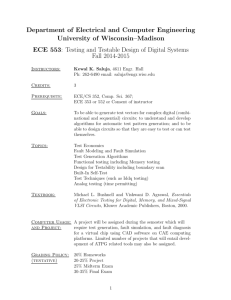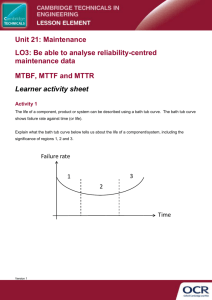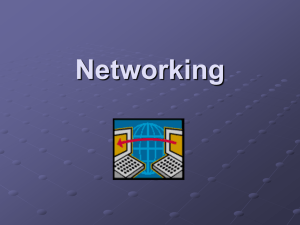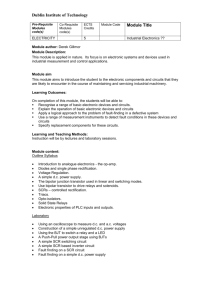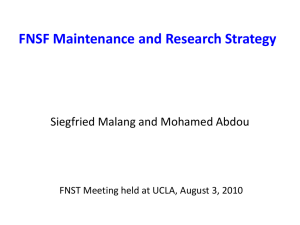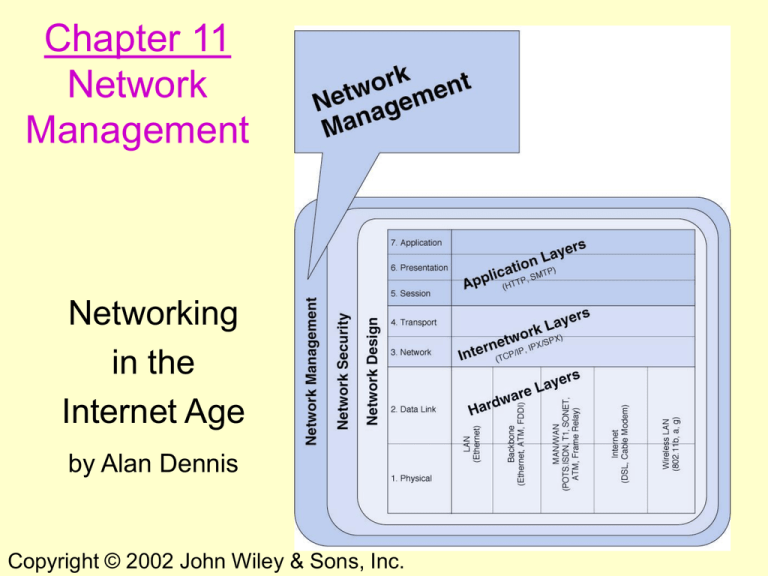
Chapter 11
Network
Management
Networking
in the
Internet Age
by Alan Dennis
1
Copyright © 2002 John Wiley & Sons, Inc.
Copyright John Wiley & Sons, Inc. All rights reserved.
Reproduction or translation of this work beyond that named in
Section 117 of the United States Copyright Act without the
express written consent of the copyright owner is unlawful.
Requests for further information should be addressed to the
Permissions Department, John Wiley & Sons, Inc. Adopters of
the textbook are granted permission to make back-up copies for
their own use only, to make copies for distribution to students of
the course the textbook is used in, and to modify this material to
best suit their instructional needs. Under no circumstances can
copies be made for resale. The Publisher assumes no
responsibility for errors, omissions, or damages, caused by the
use of these programs or from the use of the information
contained herein.
2
Chapter 11. Learning Objectives
• Understand what is required to manage the
day-to-day operation of networks
• Be familiar with the network management
organization
• Understand configuration management
• Understand performance and fault
management
• Be familiar with end user support
• Be familiar with cost management
3
Chapter 11. Outline
• Introduction
• Organizing the Management Function
– The Shift to LANs and the Internet
– Integrating LANs, WANs and the Internet
– Integrating Voice and Data Communications
• Configuration Management
– Configuring the Network and Client Computers
– Documenting the Configuration
• Performance and Fault Management
– Network Monitoring, Failure Control Function, Performance and
Failure Statistics, Improving Performance
• End User Support
– Resolving Problems, Providing End User Training
• Cost Management
– Sources of Costs, Reducing Costs
4
Introduction
5
Introduction
• Network management means monitoring and
controlling the network so that it is working
properly and providing value to its users.
• A lack of planning and organization can mean that
network managers spend most of their time
firefighting - dealing with breakdowns and
immediate problems.
• The four main areas of network management are:
–
–
–
–
configuration management
performance and fault management
end user support
cost management
6
Organizing the Management
Function
7
The Shift to LANs and the Internet
• Since the 1980’s networks have moved from using
mainframes and terminals to PCs, LANs and the Internet.
• Mainframes are still important, but network management
now focuses more on LANs, BNs and Internet resources.
• Currently, a critical issue is the integration of organizational
networks and applications. The two main problems are:
– the technical compatibility of technologies and protocols.
– cultural differences in personalities and management
styles of network managers. WAN & mainframe
managers prefer more highly structured and controlled
environments than do LAN and Web managers.
8
Integrating Voice & Data
Communications
• Traditionally, voice and data networks were
separate, i.e., the telephone system and the
organizational LAN, respectively.
• Separate networks mean higher network costs as
well as additional staffing requirements.
• Integrating voice and data simplifies the network,
and can lower network costs.
• Most organizations will likely integrate voice and
data within the next 5 years.
9
Configuration Management
10
Configuring the Network and Client
Computers
• Configuration management means configuring
the network’s hardware and software and
documenting that configuration.
• Two common configuration activities are
– adding and deleting user accounts.
– updating the software on the client computers
attached to the network.
• Electronic software delivery (ESD) can be used to
manage costs by eliminating the need to manually
update programs on each and every client
computer.
11
Documenting Hardware and Software
• Configuration documentation includes information
on network hardware, software, and user and
application profiles.
• Net hardware documentation uses a set of maps
(see Figure 11-1).
• These must be supplemented with lists of
hardware, details on each component such as
serial number, vendor, date of purchase, warranty
information, repair history, phone number for
repairs, etc.
• Documenting network software is similar, but
includes other information such as the network
OS, software release date and site license details. 12
Figure 11-1
Network
Configuration
Diagram
(source:
netViz)
13
Documenting User and Application
Profiles
• The third documentation type is the user and
application profiles, which should be
automatically provided by the network operating
system or outside software agreements.
• Other network documentation that must be
routinely developed and updated include software,
standards and operations manuals, vendor
contracts, and licenses.
• Documentation should include details about
performance and fault management, maintenance
guidelines, disaster recovery plans, end user
support and cost management.
14
Performance and Fault
Management
15
Performance and Fault Management
• Performance management: ensuring the network
is operating as efficiently as possible.
• Fault management: preventing, detecting, and
correcting faults in the network circuits, hardware,
and software.
• The two are interrelated. Both require network
monitoring, i.e., tracking the operation of network
circuits and devices to determine how heavily they
are being used and ensure they are operating
properly.
16
Network Monitoring
• Most organizations use network
management software to monitor and
control their networks.
• The parameters monitored by a network
management system fall into two distinct
categories: physical network statistics and
logical network information.
17
Network Monitoring Parameters
• Physical network statistics come from monitoring
the operation of modems, multiplexers, and
circuits linking hardware devices.
• Logical network parameters are monitored by
performance measurement systems that track user
response times, traffic volume on a specific
circuit, the destinations of network packets, and
other indices showing the network’s service level.
• Performance tracking is important since it
enables net managers to be proactive and respond
to problems before users complain, otherwise
network management can revert to firefighting.
18
Failure Control Function
• Failure control requires problem reporting, often
handled by the help desk.
• A central troubleshooting group should also be
responsible for contacting hardware, software
vendors or common carriers.
• To aid in network monitoring, managed devices
are now being installed that record data on the
messages they process and send this information
back to a central management database.
• Numerous software packages are available for
recording fault information. These produce reports
called trouble tickets.
19
Handling Network Problems
• Managers use trouble tickets to do problem
tracking, enabling them to systematically address
problems, tracking who is responsible for problem
correction and how it is being resolved.
• This also allows problem prioritization ensuring
critical problems get higher priority.
• Finally, maintaining a trouble log is helpful for
reviewing problem patterns on the network and
can be used to identify which network components
are the most problematic.
20
Performance and Failure Statistics
• The main performance statistics are the number of
packets moved on a circuit and the response time.
• Another factor is availability; the percent of time the
network is available. Downtime is the percent of
time the network is not available.
• Failure statistics include:
– Mean time between failures (MTBF) indicates the
reliability of a network component.
– Mean time to repair (MTTR) equal to the mean time to
diagnose plus the mean time to respond plus the mean
time to fix a problem.
MTTRepair = MTTDiagnose + MTTRespond + MTTFix
21
Figure 11-2 Quality Control Chart for circuits
22
More on MTBF and MTTR
• Service level agreements for the MAN/WAN include
MTBF and MTTR for their circuits.
• MTTR is typically 2-4 hours.
• For LANs, MTBF depends on the manufacturer;
typically 3-5 years for low cost hardware and 10
years for high cost equipment.
• MTBF for network software embedded devices is
about 3-6 months (meaning a system crash will
occur ~2-4 times per year).
• The average MTTR for such a software failure is
about 2 hours, depending on network staff.
23
End User Support
24
End User Support
• Supporting end users means solving the
problems users have using the network.
• End user support can be grouped into three
areas:
– Resolving network problems
– Resolving software problems
– Training
25
Resolving Problems
• Problems stem from three major sources:
– Hardware device failures
– A lack of user knowledge on proper operation
– Problems with software, software settings or software
compatibility
• Problem resolution in large organizations is
organized at three levels:
– The help desk handles basic questions
– If this is not enough, staff members with specialized
skills specific to the problem at hand are brought in
– If second level specialists are still not enough, technical
specialists with an even higher level of training are
contacted to look into the problem.
26
Providing End User Training
• End-user training needs to be an ongoing
part of network management.
• Training programs are also important since
employees often change jobs within an
organization and so the organization can
benefit from cross-training.
• Training is usually conducted using in-class
or one-on-one instruction or online or using
training materials provided online.
27
Cost Management
28
Cost Management
• Because of its large and rapidly growing budget,
network management must carefully monitor
network costs and will likely be called upon to
justify cost increases.
• This requires measuring the cost of supporting
users, allocating networking department budgets
between hardware, software, personnel and other
costs and understanding how these costs are
changing.
29
Total Cost of Ownership
• The total cost of ownership (TCO) is a measure of
how much it costs per year to keep one computer
operating.
• TCO studies indicate it can cost up to five times
the price of the computer to keep it operational.
• The TCO for a typical Windows computer is about
$8-12,000 per computer per year.
• Although TCO has been widely accepted, many
organizations disagree with the practice of
including user “waste” time in the measure and
prefer to focus on costing methods that examine
only the direct costs of operating the computer.
30
Net Cost of Ownership
• Net Cost of Ownership (NCO) is an alternative to
TCO that measures only direct costs, leaving out
so-called “wasted” time.
• NCO costs per computer are between $1500$3500, meaning that the network management for
a 100-user network would require an annual
budget of between $150,000-$350,000.
• Using NCO, the largest network budget items are:
– 1. Personnel cost, accounting for 50-70% of costs
– 2. WAN circuits
– 3. Hardware upgrades and replacement parts.
31
Network Personnel Costs (Figure 11-3)
• Since the largest item in any network
budget today is personnel time, cost
management needs to focus on ways to
reduce personnel time, not hardware costs.
• The largest use of personnel time is in
systems management.
• The second largest use of personnel time is
user support.
32
Fig. 11-3 Network management personnel costs 33
Managing Network Budgets
• Network managers can find it difficult to manage
their rapidly growing budgets.
• Some organizations use charge-back policies for
WAN and mainframe use as a cost accounting
mechanism.
• Charge-back policies attribute costs associated
with the network to specific users.
• Charge-back policies are difficult to implement on
LANs, however.
34
Fig. 11-4. Reducing Network Costs
Five Steps to Reducing Network Costs:
1. Develop standard hardware and software
configurations for client computers and servers.
2. Automate as much of the network management
function as possible by deploying a solid set of
network management tools.
3. Reduce the costs of installing new hardware and
software by working with vendors.
4. Centralize help desks.
5. Move to thin client architectures.
35
End of Chapter 11
36

